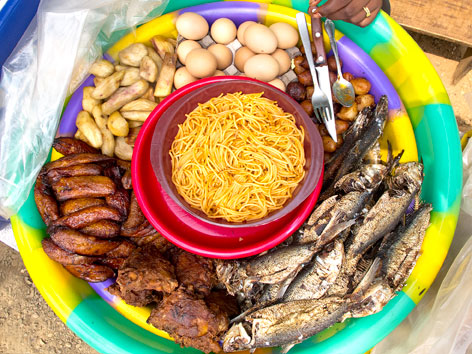SPECIAL REPORT: Famine Early Warning System (FEWS NET/USAID) on ebola’s effects on Sierra Leone food production

Weak purchasing power and market disruptions reduce food access for poor households
Guinea, Liberia, and Sierra Leone are FEWS NET remote monitoring countries. In remote monitoring, a coordinator typically works from a nearby regional office. Relying on partners for data, the coordinator uses scenario development to conduct analysis and produce monthly reports. As less data may be available, remote monitoring reports may have less detail than those from countries with FEWS NET offices. The analysis presented in this report is based on various field information from sources including FEWS NET key informants, a recent SMS-based trader survey conducted by FEWS NET and GeoPoll, and partner information.
Current situation Sierra Leone
Ebola caseload
According to the World Health Organization (WHO), there has been a total of 9,004 confirmed, probable, and suspected cases of Ebola in Sierra Leone as of December 21. Recently, the number of new cases appears to have slowed although a large number of cases have recently been observed in the districts of Kono, Bo, Tonkolili, Bombali, Port Loko, Kambia, and the Urban and Rural Western Areas.Agricultural production
According to estimates by WFP and FAO, national 2014/15 rice production will likely be 1,155,114 tonnes, down 8 percent compared to 2013 levels (a record production year), due to labor constraints caused by Ebola-related fears and official restrictions on population movements. According to FEWS NET’s calculations, this production estimate would suggest a 7 percent increase in rice production compared to the five-year average. Cassava, which is less labor intensive than other crops, has been less affected by the outbreak with national production down 3 percent compared to 2013 levels.At a sub-national level, WFP and FAO estimates indicate that Kailahun, an early epicenter in the Ebola outbreak, will experience the sharpest production declines with rice and cassava production down 17 percent and 6 percent, respectively, compared to 2013 levels. Meanwhile, FEWS NET’s key informants report that harvests will be slightly to moderately above average in Kono, Tonkolili, and Koinadugu, three areas with fewer Ebola cases earlier in the cropping season. However, in both Bonthe and Pujehun, two other areas less impacted by Ebola earlier in the year, production is still estimated to be slightly below average due to flooding in these districts.
Market functioning
Ebola-related fears have significantly disrupted trade flows across Sierra Leone. During the month of December, the districts of Kono and Tonkolili were placed under two week quarantines, adding to the growing list of quarantined districts within the country, including Kailahun, Kenema, Port Loko, Bombali, and Moyamba. In other areas, roadblocks and chiefdom-level quarantines are also restricting population movements. While trucks carrying food have been allowed to enter quarantined zones with the proper government paperwork, these quarantines have increased transportation costs and slowed the movement of goods. With regards to cross- border trade, the border with Guinea has recently opened, although trade flows continue to be at reduced levels. All cross-border points with Liberia are still closed.With regards to market functioning, only 8 to 9 percent of traders surveyed by FEWS NET using a SMS-based GeoPoll survey in mid-November reported that local markets (daily or weekly) were closed, despite an official ban by the government on weekly markets. In addition, another 44 to 45 percent of surveyed traders reported that markets in their communities were open but operating at reduced levels. The highest rates of traders reporting reduced weekly market functioning were observed in the districts of Bombali, Kailahun, Kambia, Kono, Moyamba, Pujehun, and Tonkolili.
Market supply levels and food availability
FEWS NET’s recent trader survey also found that over 50 percent of traders in Bo, Bonthe, Kambia, Kenema, Moyamba, and Port Loko reported that their food stocks were currently at below-average levels, most often due to movement restrictions and high transport costs. Meanwhile, the lowest percentage of traders reporting below-average stocks was observed in Tonkolili (6 percent). Key informant reports indicate that Tonkolili is generally less dependent on trade flows from neighboring districts and had a relatively average harvest, which may explain the district’s better supply levels.When asked about local food availability, 47 percent of surveyed traders reported that available food would be inadequate to meet the needs of local consumers. The highest percentage of traders reporting poor food availability (over 50 percent) was observed in Bo, Kenema, Kono, Moyamba, Port Loko, and Pujehun while the lowest percentage was in Kailahun (27 percent). The results of the survey indicated no clear relationship between reported stocks levels/food availability and quarantined areas.
Food prices
Due to the ongoing harvests, November food prices for most commodities declined seasonally compared to October levels. Exceptions to this include imported rice in Kenema where prices increased 8 percent. Historical time series data is limited but for markets where November 2013 price data is available, imported rice prices are generally similar or above last year’s levels. However, for local rice and cassava, price trends are variable with prices below last year’s levels in Pujehun and Port Loko but well above in Freetown. According to key informant information, supply routes into Freetown have been significantly disrupted due to roadblocks and checkpoints, which may be contributing to higher prices for locally produced commodities in the capital city.Household incomes
According to key informant information, incomes from a variety of sources are down this year due to the economic impacts of the Ebola outbreak. For agricultural households, slightly to moderately below-average harvests and the closure of local weekly markets where households normally sell their crops have reduced crop sales and related household incomes. Border closures, restrictions on population movements, and increased transportation costs have also reduced petty trade and opportunities to sell cash crops (ex. market gardening crops and palm oil). With regards to animal sales, a ban on bush meat sales has reduced incomes for those who normally sell this product. Meanwhile for small ruminants and poultry, the impact of the Ebola outbreak is varied, with reduced sales in some areas due to market disruptions but increased sales and prices in other areas due to stronger demand caused by the bush meat ban. In several areas of the country, charcoal production has reportedly intensified to help offset the effects of below-average incomes from other sources. However, producer prices for this product vary throughout the country, with normal or slightly below-average prices in most areas, but atypically high prices in certain zones where humanitarian organizations have been making charcoal purchases for humanitarian distributions.Current food security outcomes
In many areas of Sierra Leone, households have been unable to earn typical levels of income through crop sales and non- agricultural activities. This, along with reduced market functioning, market closures, and quarantine measures have limited food availability and access in some communities. Although very poor and poor households in much of the country are still able to minimally meet food needs through ongoing harvests, they are unable to cover essential non-food expenditures and are currently Stressed (IPC Phase 2). Meanwhile, in Koinadugu, Tonkolili, and Bonthe, areas with a higher proportion of rural, agricultural households, food security conditions have been more favorable due to reduced impacts of the Ebola outbreak on crop production and a lower dependence on internal and cross-border trade for food supplies. In these areas, most households are currently minimally meeting both food and nonfood needs and are facing Minimal (IPC Phase 1) food insecurity.Assumptions
The most likely food security scenario for December 2014 through June 2015 is based on the following assumptions:
- Ebola outbreak: The number of new Ebola cases will continue to grow substantially through the first quarter of 2015 at a rate that is relatively similar to current levels, before then slowing later in the year. There will be a relatively large number of new cases in Freetown and a more even distribution of cases throughout the rest of the country.
- 2014 cropping activities: The ongoing rice harvests will continue through January, but at slightly reduced levels in areas worst-affected by the Ebola outbreak due to labor constraints. Off-season agricultural production is also expected to be slightly below average due to limited labor and a lack of agricultural inputs.
- Household food stocks: The duration of household food stocks this year will vary depending on the zone. In areas where labor constraints had the most significant impact on crop production, such as Kailahun, food stocks will deplete one to two months earlier than normal. However, in other areas where production was less impacted (ex. Kono, Tonkolili and Koinadugu), the duration of household food stocks will be similar to a normal year. Households with family members who have died or been ill with Ebola will also likely have lower than usual stocks resulting from the effects of quarantines and the loss of productive family members due to the illness and caregiving responsibilities.
- Household incomes: Most households will face below-average incomes from typical sources (cash crops, petty trade, labor, bush meat sales, mining, forest product sales, etc.) during the outlook period due to an unfavorable economic environment.
- Trade flows: Internal trade flows will continue to be limited due to Ebola-related fears, particularly in quarantined areas and those worst-affected by the Ebola outbreak. With regards to cross-border trade, some border crossings will open during the outlook period and will favor exchanges between Sierra Leone and neighboring countries compared to December levels, although exchanges will remain below average.
- Market functioning: Most markets will remain open during the entire outlook period, operating at reduced levels. However, limited market supply and elevated levels of market demand for rice will begin to be observed in January, slightly earlier than normal, in areas worst-affected by Ebola due to the effects of this year’s below-average production. In addition, demand for cassava will be atypically high starting in April as poor households substitute towards this product due to low rice stocks and weak household purchasing power.
- Food prices: Between December and January, prices will remain relatively stable or in decline, particularly in the main agricultural production areas. Starting in February, prices will begin to rise seasonally and will evolve to above average levels between April and June due to atypically strong demand and low food stock levels. Due to transportation disruptions, price increases compared to average will be greatest for locally produced products (rice and cassava) in urban centers, such as Freetown. Meanwhile for imported rice, the largest increases will be observed in isolated rural areas far from the port city of Freetown.
- 2015 rainfall: Forecasts from major meteorological centers (IRI, CPC, ECMWF) are indicating no major anomalies between January and June 2015. As a result, FEWS NET is assuming that rainfall will be relatively normal, with low levels of precipitation between January and March and increased levels between April and June.Projected outcomes
Due to atypically low incomes resulting from below-average production and the closure of some weekly and cross-border markets, poor households in many areas of the country will face Stressed (IPC Phase 2) food security outcomes during the outlook period. More specifically, they will be unable to cover their essential non-food expenditures due to low purchasing power and a lack of adequate food access and availability. In areas where disruptions to agricultural production and market activities have been most severe, such as Kailahun, Kenema, Bombali, Port Loko, and Moyamba, poor households will likely face small to moderate food consumption gaps, equivalent to Crisis (IPC Phase 3) between January and June.
Meanwhile in Tonkolili, food security conditions are more favorable due to an average rice production and low dependence on internal or cross-border trade for food supplies at this time of the year. In this district, households will face normal food access and Minimal (IPC Phase 1) acute food insecurity between December 2014 and March 2015 before declining into Stress (IPC Phase 2) between April and June. DOWNLOAD FULL REPORT ON LIBERIA & GUINEA
Leave a reply
You must be logged in to post a comment.













